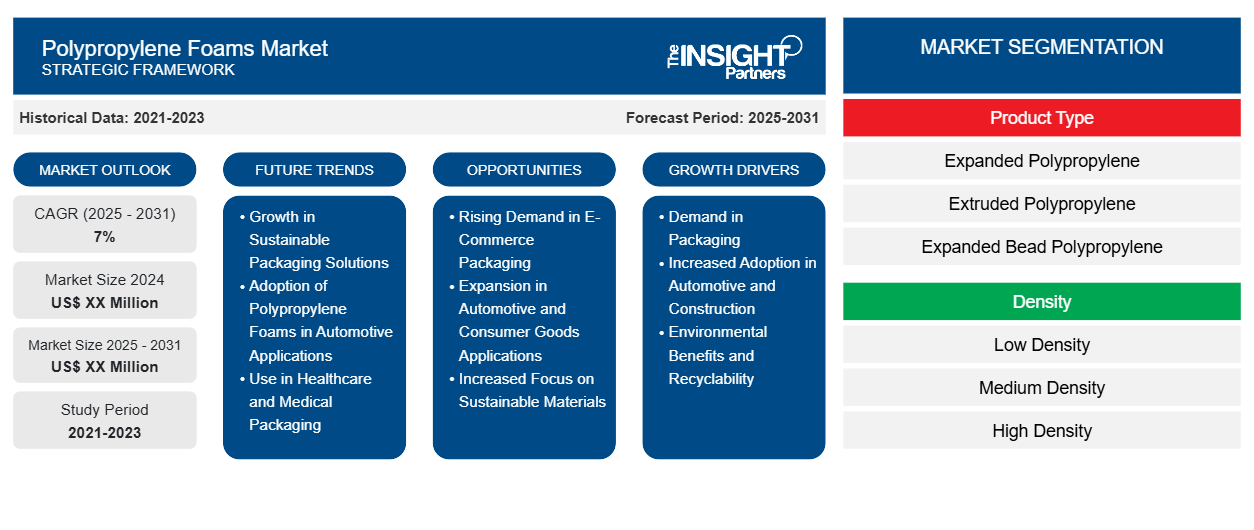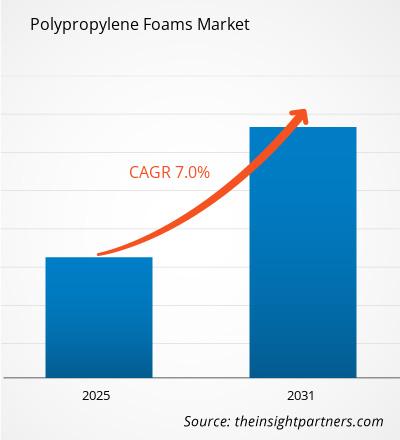The Polypropylene Foams Market is expected to register a CAGR of 7% from 2025 to 2031, with a market size expanding from US$ XX Million in 2024 to US$ XX Million by 2031.
The polypropylene foams market report is segmented by Product Type (Expanded Polypropylene (EPP), Extruded Polypropylene (XPP), Expanded Bead Polypropylene, Others). The market is segmented based on Density (Low Density, Medium Density, High Density). The market size and forecast at global, regional, and country levels for all the key market segments are covered under the scope. The report offers the value in USD for the above analysis, segments, regions, and countries. The report covers market trends, as well as market dynamics such as drivers, restraints, and key opportunities. The report also covers industry landscape and competition analysis covering market concentration, heat map analysis, prominent players, and recent developments in the market.
Purpose of the Report
The report Polypropylene Foams Market by The Insight Partners aims to describe the present landscape and future growth, top driving factors, challenges, and opportunities. This will provide insights to various business stakeholders, such as:
- Technology Providers/Manufacturers: To understand the evolving market dynamics and know the potential growth opportunities, enabling them to make informed strategic decisions.
- Investors: To conduct a comprehensive trend analysis regarding the market growth rate, market financial projections, and opportunities that exist across the value chain.
- Regulatory bodies: To regulate policies and police activities in the market with the aim of minimizing abuse, preserving investor trust and confidence, and upholding the integrity and stability of the market.
Polypropylene Foams Market Segmentation
Product Type
- Expanded Polypropylene
- Extruded Polypropylene
- Expanded Bead Polypropylene
Density
- Low Density
- Medium Density
- High Density
Processing Method
- Bead Foam Processing
- Extrusion Processing
- Injection Molding
End-Use Industry
- Automotive
- Packaging
- Construction
- Consumer Goods
You will get customization on any report - free of charge - including parts of this report, or country-level analysis, Excel Data pack, as well as avail great offers and discounts for start-ups & universities
Polypropylene Foams Market: Strategic Insights

-
Get Top Key Market Trends of this report.This FREE sample will include data analysis, ranging from market trends to estimates and forecasts.
Polypropylene Foams Market Growth Drivers
- Demand in Packaging: Polypropylene foams are widely used in the packaging industry due to their lightweight and protective characteristics. As e-commerce continues to grow, the need for efficient, cost-effective, and protective packaging solutions has risen. Polypropylene foams, being durable, lightweight, and resistant to moisture, are ideal for protective packaging in shipping and logistics, particularly for fragile items, which drives market growth.
- Increased Adoption in Automotive and Construction: Polypropylene foams are increasingly being used in automotive and construction applications due to their excellent insulation, soundproofing, and energy efficiency properties. In the automotive sector, they are used for interior components, providing comfort and noise reduction. In construction, they are used as insulation materials to improve energy efficiency, especially in green building projects, thus expanding their market reach.
- Environmental Benefits and Recyclability: Polypropylene foams are considered more environmentally friendly compared to other types of foams, such as polystyrene, due to their lower environmental impact and higher recyclability. As sustainability concerns increase, manufacturers are opting for materials that are easier to recycle and have less environmental toxicity. This trend towards greener materials is encouraging the growth of the polypropylene foams market, particularly in industries such as packaging and automotive.
Polypropylene Foams Market Future Trends
- Growth in Sustainable Packaging Solutions: As environmental concerns rise, the demand for sustainable and eco-friendly packaging is becoming a key trend. Polypropylene foam, being recyclable and offering a lower environmental impact compared to alternatives like polystyrene, is gaining popularity in industries such as food, electronics, and e-commerce. This shift toward sustainable packaging is expected to drive market growth, with companies focusing on creating more biodegradable and recyclable foam products.
- Adoption of Polypropylene Foams in Automotive Applications: Polypropylene foams are increasingly being used in automotive manufacturing for applications such as soundproofing, insulation, and energy absorption. As automakers prioritize passenger comfort and vehicle safety, the demand for polypropylene foams in automotive interiors and structural components is expected to rise. This trend will continue to expand as the automotive industry adopts more advanced lightweight materials for improved fuel efficiency and performance.
- Use in Healthcare and Medical Packaging: The healthcare sector is expected to become a significant consumer of polypropylene foams due to their ability to provide lightweight, sterile, and protective packaging for medical devices, pharmaceuticals, and sterile products. The increasing demand for high-quality, safe, and efficient medical packaging solutions will propel market growth, especially as healthcare packaging regulations continue to evolve to ensure product safety and quality.
Polypropylene Foams Market Opportunities
- Rising Demand in E-Commerce Packaging: The growth of e-commerce and online retail is driving the demand for protective packaging, with polypropylene foams playing a key role. As online shopping continues to expand, the need for durable, lightweight, and protective packaging materials is increasing. Polypropylene foams offer the ideal solution for packaging fragile and high-value items, creating a substantial market opportunity in the packaging industry.
- Expansion in Automotive and Consumer Goods Applications: The demand for lightweight, energy-absorbing materials in the automotive and consumer goods industries is another opportunity for polypropylene foams. In automotive manufacturing, they are used for components like interior padding, insulation, and soundproofing. In consumer goods, polypropylene foams are used for cushioning delicate products. This growing demand for high-performance, cost-effective materials in both sectors presents a significant market growth opportunity.
- Increased Focus on Sustainable Materials: As industries face increasing pressure to adopt sustainable practices, polypropylene foams are gaining attention for their recyclable properties. The market has an opportunity to capitalize on this demand by promoting polypropylene foam’s environmental benefits compared to non-recyclable alternatives like polystyrene. Developing and marketing more sustainable and recyclable foam products can position companies to benefit from the growing focus on environmental responsibility.
Polypropylene Foams Market Regional Insights
The regional trends and factors influencing the Polypropylene Foams Market throughout the forecast period have been thoroughly explained by the analysts at The Insight Partners. This section also discusses Polypropylene Foams Market segments and geography across North America, Europe, Asia Pacific, Middle East and Africa, and South and Central America.
Polypropylene Foams Market Report Scope
| Report Attribute | Details |
|---|---|
| Market size in 2024 | US$ XX Million |
| Market Size by 2031 | US$ XX Million |
| Global CAGR (2025 - 2031) | 7% |
| Historical Data | 2021-2023 |
| Forecast period | 2025-2031 |
| Segments Covered |
By Product Type
|
| Regions and Countries Covered |
North America
|
| Market leaders and key company profiles |
|
Polypropylene Foams Market Players Density: Understanding Its Impact on Business Dynamics
The Polypropylene Foams Market is growing rapidly, driven by increasing end-user demand due to factors such as evolving consumer preferences, technological advancements, and greater awareness of the product's benefits. As demand rises, businesses are expanding their offerings, innovating to meet consumer needs, and capitalizing on emerging trends, which further fuels market growth.

- Get the Polypropylene Foams Market top key players overview
Key Selling Points
- Comprehensive Coverage: The report comprehensively covers the analysis of products, services, types, and end users of the Polypropylene Foams Market, providing a holistic landscape.
- Expert Analysis: The report is compiled based on the in-depth understanding of industry experts and analysts.
- Up-to-date Information: The report assures business relevance due to its coverage of recent information and data trends.
- Customization Options: This report can be customized to cater to specific client requirements and suit the business strategies aptly.
The research report on the Polypropylene Foams Market can, therefore, help spearhead the trail of decoding and understanding the industry scenario and growth prospects. Although there can be a few valid concerns, the overall benefits of this report tend to outweigh the disadvantages.
Frequently Asked Questions
What is the expected CAGR of the polypropylene foams market?
What are the driving factors impacting the polypropylene foams market ?
What are the key players operating in the polypropylene foams market?
Which is the fastest growing segment based on product type?
Based on geography, which region held the largest share of the polypropylene foams market?
What is the future trend for polypropylene foams market?
- Historical Analysis (2 Years), Base Year, Forecast (7 Years) with CAGR
- PEST and SWOT Analysis
- Market Size Value / Volume - Global, Regional, Country
- Industry and Competitive Landscape
- Excel Dataset
Recent Reports
Testimonials
Reason to Buy
- Informed Decision-Making
- Understanding Market Dynamics
- Competitive Analysis
- Identifying Emerging Markets
- Customer Insights
- Market Forecasts
- Risk Mitigation
- Boosting Operational Efficiency
- Strategic Planning
- Investment Justification
- Tracking Industry Innovations
- Aligning with Regulatory Trends





















 Get Free Sample For
Get Free Sample For